From the Introduction to A Field Guide to Radiation:
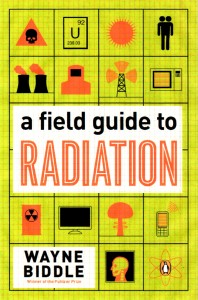 Since the Manhattan Project made the energy that holds matter together available as a useful source of power, there have been five occasions when life has been threatened on a wide scale by atomic devices: the bombing of Hiroshima and Nagasaki in 1945; the outdoor testing of nuclear weapons in many locations from 1945 to 1980; the reactor meltdown at Three Mile Island in Pennsylvania in 1979; the reactor explosion at Chernobyl in Ukraine in 1986; and the multiple reactor failures at Fukushima in Japan in 2011. Although radiation is a fundamental process of the universe, these events of the last seven decades represent together the first time in 3.8 billion years that radiation has harmed life in an acute way.
Since the Manhattan Project made the energy that holds matter together available as a useful source of power, there have been five occasions when life has been threatened on a wide scale by atomic devices: the bombing of Hiroshima and Nagasaki in 1945; the outdoor testing of nuclear weapons in many locations from 1945 to 1980; the reactor meltdown at Three Mile Island in Pennsylvania in 1979; the reactor explosion at Chernobyl in Ukraine in 1986; and the multiple reactor failures at Fukushima in Japan in 2011. Although radiation is a fundamental process of the universe, these events of the last seven decades represent together the first time in 3.8 billion years that radiation has harmed life in an acute way.
We live under a kind of duress for which we did not evolve. And we are trapped, because the bombs and reactors cannot be completely removed now. Even if the construction of new ones were halted and the old structures were destroyed, the huge quantities of radioactive material that fueled them will remain dangerous for tens of thousands of years. And we have no safe place to put it all–just defining what “safe” could mean for that much time seems absurd. Nuclear technology has the alarmingly unique characteristic that intentional or accidental release of massive amounts of radiation from this fuel in a small locality quickly spreads around the globe, creating hazards far away. In effect, our planet is newly hostile, and we need to find a practical way to mitigate the risk of living on it.
The atom, the bomb, and the reactor have occupied the minds of many brilliant men and women. The pioneer physicists and radiochemists existed in such tight coteries that they often seemed oblivious to the implications of their work. War changed that, of course, but science and engineering and medicine are always isolated from wider circles by technical language and hauteur that exclude nonexperts. This might be tolerable if the laboratory were truly isolated from the street, but ever since Henri Becquerel noticed photographic film being fogged by something shut inside a drawer on a cloudy Paris day, there has been no escape for anyone from radiation above and beyond what the gods intended.
“an indispensable volume for every library”–Booklist
“Witty, succinct and handily organized in an A–Z format.”–Nature
“an overview of man-made radiation, decoding the terminology and helping readers to understand the difference between beryllium and beta particles”–Washington Post
“The book is irreverent and free of jargon. Biddle — one is tempted to say — illuminates how radiation is a part of everyday life through everything from cell phones to X-rays. In chapters like Fission/Fusion, Gamma Rays and Geiger Counter, Biddle smartly explains these topics and refuses to use the technical language that isolates scientists from the rest of the world.”–Chicago Tribune (Editor’s Choice)
“This book is a pleasure to read; it is chock-full of information and thought-provoking. Highly recommended.”–Choice
“We live in a proverbial radiation quilt. Nuclear power, x-rays, ultraviolet rays, muons, microwaves, radio waves, and electromagnetic radiation are everywhere. In case you were wondering how to navigate around these, Wayne Biddle’s A Field Guide to Radiation will be available.”–Wired
“an interesting guide to the nuclear age”–Science News
An interview on National Public Radio station WYPR is at http://programs.wypr.org/podcast/field-guide-radiation-wednesday-september-12-1-2-pm
An interview on C-Span Book TV (1/25/15) is at http://www.c-span.org/video/?323269-1/book-discussion-field-guide-radiation
Japanese edition, Spring 2013:
From the Introduction to Dark Side of the Moon:
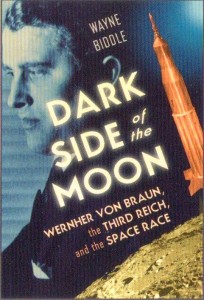 “Do you think scientists should be blamed for wars? Einstein? He looked for fundamental truths and his formula was used for an atomic bomb. Alexander Graham Bell? Military orders that kill thousands are transmitted over his telephone. Why not blame the bus driver who takes war workers to their factories? How about movie actors who sing for the USO?” These comments may sound philistine today, but they were made six years after the end of World War II in a respectful article in The New Yorker magazine by a man then well on his way to becoming one of the era’s most famous and revered technologists. The German “rocket scientist” Wernher von Braun, who had played a principal role in creating the V-2 “wonder weapon” for the Third Reich, had come to America under U.S. Army auspices to continue his work. What he had really been doing all along was developing the means to travel into outer space, he claimed time and again. Most of his audience never doubted it.
“Do you think scientists should be blamed for wars? Einstein? He looked for fundamental truths and his formula was used for an atomic bomb. Alexander Graham Bell? Military orders that kill thousands are transmitted over his telephone. Why not blame the bus driver who takes war workers to their factories? How about movie actors who sing for the USO?” These comments may sound philistine today, but they were made six years after the end of World War II in a respectful article in The New Yorker magazine by a man then well on his way to becoming one of the era’s most famous and revered technologists. The German “rocket scientist” Wernher von Braun, who had played a principal role in creating the V-2 “wonder weapon” for the Third Reich, had come to America under U.S. Army auspices to continue his work. What he had really been doing all along was developing the means to travel into outer space, he claimed time and again. Most of his audience never doubted it.
Later generations largely forgot about him, as the imperatives of the Space Age grew quaint. But it is reasonable to posit that no other public figure of the twentieth century was forgiven as much as Wernher von Braun, so that he could pursue his supposed dream. The army gave him a fresh identity by classifying for decades the most malevolent details of his pre-1945 life. He needed little else besides more of the incredible good luck that had propelled him out of Hitler’s Germany into General Eisenhower’s America.
There has been much biographical writing about von Braun over the years. Because of government secrecy and popular disinclination, most of it was uncritical until long after he died (of cancer) in 1977. As the archives opened up and cold war restrictions on traveling in eastern Germany relaxed, a few journalists and historians performed the investigative toil of straightening out a record that had been warped by public relations men and pervasive sycophancy.
In April 1995, I attended the fiftieth anniversary celebration in Nordhausen, Germany, of the liberation of the slave labor camp called Dora, where V-2’s were constructed. When I first saw the camp and the underground tunnels of the V-2 factory that it had supplied with forced laborers (some 20,000 of whom died in the process), the obvious fact that they were a single entity, inseparable one from the other, froze me in my tracks in more ways than one. The shock of grasping the size of the distortion concocted by von Braun and his American apologists, who either covered up the place’s horrors or maintained that being involved with the V-2 was different from being involved with the slaves–that science was above society, in largest terms–was so strong that trying to convey the nature of the lie suddenly seemed futile. Who would believe this without seeing it? Germans might cover it up to save their necks, but why would Americans help them? There is something going on here that is bigger than flying to the moon, I thought to myself.
“a passionate book that raises important moral questions”–David Holloway, New York Times Book Review (Editor’s Choice)
“In a highly charged revisionist book, Biddle fiercely questions the virtuous myth that was built up to protect von Braun, but also the morality behind his rehabilitation.”–The Times (London)
“any rose-tinted spectacles worn these past six decades will likely slip”–New Scientist
From the Preface to the 2001 Johns Hopkins University Press edition of Barons of the Sky:
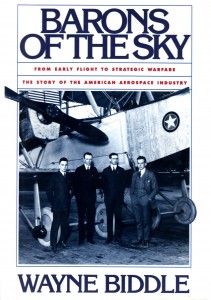 When Henry Adams encountered the mammoth dynamos displayed at the Paris Exposition of 1900, their power struck him “as a moral force, much as the early Christians felt the Cross.” Though not a religious man, his instinct, he wrote, was to pray to them, as perhaps one might worship any “symbol of infinity” and “ultimate energy.”
When Henry Adams encountered the mammoth dynamos displayed at the Paris Exposition of 1900, their power struck him “as a moral force, much as the early Christians felt the Cross.” Though not a religious man, his instinct, he wrote, was to pray to them, as perhaps one might worship any “symbol of infinity” and “ultimate energy.”
A century later, the power of technology is so commonplace that unless it actually injures us it has mostly lost such personal impact. But the moral force that Adams sensed has never gone away. Technology is still an imperative equated with progress, well-being, and even truth, despite the occasional disaster. Respectful critics of this god risk being thrown out of church by believers. So it is today, as it was a decade ago when Barons of the Sky was first published.
It seemed then that with the dissolution of the Soviet Union might come a retreat from the mountainous Cold War defense budgets that had rescued the aviation business after World War II and fueled its growth into the modern aerospace empire. But after a few years of consolidation, the weapons builders settled into the old cushion again, supported by military spending that remains enormous by any standard. The lack of an enemy state of covalent stature made no difference. Now an elusive terrorist may seem to justify almost any expenditure. One could say that there is a moral force behind buying the newest, most advanced weaponry, regardless of how suitable it is to the world at hand.
Readers coming anew to this book should therefore regard it not just as a history of technology with requisite economic and political context, but also as the record of an especially American sense of national identity. The military-industrial partnership thrives because Americans presumably believe in it (and in the threats to national security it advertises), not because its goods are always wanted or even work well. Perhaps the chimera of anti-missile defense best demonstrates this cultural trait, whereby decades pass with little or no technical advancement while billions are poured into a problem whose very definition shifts beneath the analytical foundations engineers usually require.
Maybe this rubric is too high-minded, however. Congressional investigations, court records, and the Pentagon’s own internal housekeeping reports lavishly support an alternative explanation for the perennial durability of the aerospace business, namely that the defense establishment long ago became so vast as to be self-perpetuating and unmanageable. It is certainly not the pet of any one president or party. Voters (even the small minority who follow defense issues) have no control over a wasteful system corrupted by pork-barrel politics and old-fashioned fraud. Americans don’t believe in it–they’re just stuck with it.
The early-twentieth-century founders of the industry would surely recognize the latter explanation for what their baby grew up to be. They were hard-nosed businessmen not given to philosophical introspection. They built airplanes for a living, an expensive product with no mass market. Like many entrepreneurs, they never much liked the government in Washington, but the military turned out to be their most reliable customer in an epoch of one war after another. If their products somehow became part of the American psyche, then so it goes.
Moral force or fiscal quagmire, the technology that the Wright brothers pioneered and then lost to the weapon-makers biographied here is a fundament of our age. The names of the original barons are now strung together in mergers like Lockheed Martin or dropped completely like Douglas, but the process of designing, assembling, and selling their singular merchandise depends on the same troublesome symbiosis between state and corporate purpose that coalesced in the days of linen-covered spruce.
“Timely history for Americans living in an era of $95 billion contracts for fighter planes.”–Thomas P. Hughes, New York Times Book Review (1991 Notable Book of the Year)
in memory of George Arthur Biddle, 1918-2019
From the Introduction to the 2010 third edition of A Field Guide to Germs:
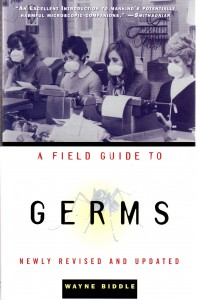 After a decade that began with Americans afraid to open their possibly infectious mail and ended with dispensers of hand sanitizer as common around college campuses as cans of beer, germs continue to fuel our daily worries. The anthrax-laced letters of 2001’s bioterrorism scare proved to be a scurrilous episode of limited scope, but the swine flu epidemic of 2009 put millions of people in bed and killed significant numbers around the world. The first story dramatized how some microbes can be “weaponized” by a criminal or simply mad intelligence– not a new development in history, but still a terrifying one. The second reminded everyone that nature’s kitchen never stops serving up fresh organisms that can make us sick if we encounter them by chance.
After a decade that began with Americans afraid to open their possibly infectious mail and ended with dispensers of hand sanitizer as common around college campuses as cans of beer, germs continue to fuel our daily worries. The anthrax-laced letters of 2001’s bioterrorism scare proved to be a scurrilous episode of limited scope, but the swine flu epidemic of 2009 put millions of people in bed and killed significant numbers around the world. The first story dramatized how some microbes can be “weaponized” by a criminal or simply mad intelligence– not a new development in history, but still a terrifying one. The second reminded everyone that nature’s kitchen never stops serving up fresh organisms that can make us sick if we encounter them by chance.
Rich nations devote vast portions of their economies to medical practice and associated work. About one-sixth of all the money spent on goods and services in the United States goes to health care: more than two trillion dollars, which is a figure difficult to grasp. Fifty years ago the fraction was one-twentieth, which means that while the whole pie has grown since then, medicine is taking a much bigger bite of it. (It is ironic that perhaps the only other industrial complex besides medicine that has garnered such bedrock support is the military, which also maintains a cloistered profession claiming skills that a fearful society should not be without.) Meanwhile, the world’s poor must survive without the fruits of this investment, preoccupied as they are with mundane problems like no sanitation, no pharmaceuticals, and no doctors at all.
For anyone able to buy and read this book, wickedly infectious microbes will continue to be rather unusual. The goal here is to sort out what is worth worrying about from what is merely fodder for those who profit from anxiety. We always have and always will live in a sea of countless invisible organisms–most of them harmless or even beneficial–that outnumber us by many orders of magnitude. We depend on them, actually. Those that might hurt us are as vulnerable as ever to medical science and, in varying degrees, our own immune systems. Indeed, there is a broad shift taking place in “morbidity and mortality,” as the professionals call sickness and death, from infectious to noncommunicable diseases like cancer. A field guide is thus offered as a bulwark against phobia and a reminder that medicine is a socioeconomic activity.
“An engaging account of the merciless microbes among us.”–Washington Post
★Winner of the American Medical Writers Association’s Walter C. Alvarez Honor Award★
From Coming to Terms:
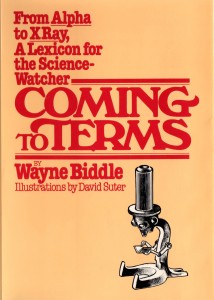 The years have taken some of the luster off C.P. Snow’s “two cultures” thesis. If, as he suggested in 1956, humanist culture has become separate from scientific culture, we seem to be trundling along with the problem as merrily as with the separation between id and ego. An enormous amount of professional intellection has gone into this sticky subject nevertheless. At times the academic debate about who is most separate from whom has itself looked more inexhaustible than the human nature that supposedly spawned it. Yet the sun has a way of coming up new every morning.
The years have taken some of the luster off C.P. Snow’s “two cultures” thesis. If, as he suggested in 1956, humanist culture has become separate from scientific culture, we seem to be trundling along with the problem as merrily as with the separation between id and ego. An enormous amount of professional intellection has gone into this sticky subject nevertheless. At times the academic debate about who is most separate from whom has itself looked more inexhaustible than the human nature that supposedly spawned it. Yet the sun has a way of coming up new every morning.
In the old days, a scientist who was not just a crazy magician was probably a man who studied theology and the classics and then turned his scholarly eye toward nature. Now, however, a scientist rarely digs any deeper into the classics than a classicist digs into the sciences. There is a degree of contemptuousness on both sides, though it is rather more pathetic to see a humanist imitate a technician by becoming narrowly focused and making parochial claims for the utility of what he knows. Why do scientists traffic in words that sound difficult to nonscientists? What does an otherwise well-informed person have to do to acquire a workable idea of their meaning? The pool of linguistic ingredients is evidently treacherous for casual recreational swimmers.
What follows is a list of words that have leaked from the safe containment of universities, research labs, and technical industries. Though some are already part of our common tongue, most are shrouded in the aggressive mystery that makes people distrust whoever utters them. The tone of the definitions may distract people who are used to formal treatments. But anyone who can stand a liturgical or cantorial script that is performed in plain English instead of Latin or Hebrew should be able to tolerate them. There really are no sacred cows. Only orthodox sensibilities.
“Unlike most dictionaries, this one can pleasurably be read straight through, from absolute zero to zero-sum game.”–People
“Biddle is by no means to science what Martin Luther was to the Roman Catholic Church, but this is a reformation of its own kind.” —Duluth Herald
From the Introduction to A Field Guide to the Invisible:
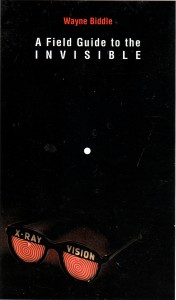 Much of everyday experience takes place beyond the range of our senses, which are ample but comparatively dull. It is our big brain that makes us superior to other creatures, for better or worse, and that also enables us to explore realms that are no less important because they are invisible.
Much of everyday experience takes place beyond the range of our senses, which are ample but comparatively dull. It is our big brain that makes us superior to other creatures, for better or worse, and that also enables us to explore realms that are no less important because they are invisible.
Invisible means everything going around and through us that we not only can’t see, but can’t do much about anyway, at least as individuals. It suggests a mode for cataloging the inescapable stew we’re in, for identifying life’s ingredients that are literally out of sight and therefore too often out of mind. There is nothing here that you could easily ascertain on a hike through the woods, yet each item is as impossible to avoid as the trees. In our contemporary predicament, where so much seems beyond personal control, helplessness requires sorting out.
“This mini-encyclopedia of the imperceptible — an unseen smorgasbord of bacteria and burps, quarks and cooties — offers a well-researched yet enjoyably irreverent look at the ‘parallel world’ that ‘we inhabit simultaneously with the one before our very eyes.'”– New York Times
“A Field Guide to the Invisible, in short, offers a bit of history, a dollop of science and at least several smidgens of tomfoolery. Seeing may be believing, we learn from this engaging little volume, but it hardly tells the whole story.”–Savannah Morning News
One of Amazon’s “Top Ten Science and Nature Books of 1998”
